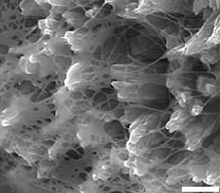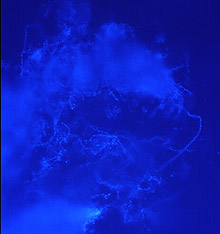
The strands of polysaccharide-like material shown in this scanning electron microphotograph is believed to be excreted from microbes that live on and within the chimney walls at Lost City. These material is commonly associated with biofilms. Click image for larger view and image credit.
Microscopic Citizens of the Lost City
William (Billy) J. Brazelton
Ph.D Oceanography Student
University of Washngton
"Microbial habitat" may not be the first idea that pops into your head upon seeing the graceful, white chimneys of the Lost City. Nevertheless up to one billion cells of micro-organisms inhabit each gram of the enormous carbonate structures. Such a high biomass of microbes may play a significant role in bio-geochemical processes at Lost City. Determining exactly what role the microbes play, however, is a major question that drives our research.
Methane-based life
People like to eat organic compounds. Pizza, peanut butter, and chocolate are among my favorites. Unfortunately, not much pizza or peanut butter is available to organisms living inside carbonate chimneys at the Lost City. Instead, significant amounts of methane and hydrogen gas are entrained within the fluids venting out of the chimneys. So, perhaps not surprisingly, within the chimneys there are colonies of micro-organisms that like to "eat" methane and hydrogen gas. Eating nothing but methane and hydrogen gas (especially without any organic compounds or oxygen) would kill you and me very quickly. Yet for these microbes, it's the best way to extract energy for growth and reproduction.

Colonies of microbes are attached to carbonate material from within the chimney walls. Some colonies form filamentous strands, such as the one shown in the far right of this microphotograph. Eash small dot (microbe) that makes up the strand is about 1 micron in size. Click image for larger view and image credit. (HR)
We believe that a very high proportion of the organisms living within the chimney walls are using the hydrogen gas to make more methane. Organisms that generate methane are known as methanogens. The methane produced by the Lost City methanogens is consumed by other species of microbes. And just as organic matter synthesized by green plants from carbon dioxide, sunlight, and water provides food for you and me, the organic matter created by the methanogens feeds other species at the Lost City. Rather than using water and sunlight, methanogens create organic matter from carbon dioxide and hydrogen gas, and they do so at temperatures possibly reaching 90°C - 194°F!
The organic matter synthesized by the methanogens (as well as whatever organic matter happens to fall to the seafloor from above) is consumed and re-consumed probably all the way up the food chain to the amphipods and fish that live near the chimneys. In this way, the methanogens could be converting the chemical energy of hydrogen gas to support an entire ecosystem of living organisms.
Have you thanked a microbe today?
Methanogens are found in a variety of locations in addition to hydrothermal vents including soils, swamps, rice fields, termites, cows and other animals. Because of the methanogens, all of these places are potential sources of methane to the atmosphere. Methane is four times more efficient as a greenhouse gas than carbon dioxide, so if large amounts of methane escape into our atmosphere, the temperature of the globe could rise very quickly. Luckily, there are microbes that eat methane and help to counter-balance the methane production of the methanogens.
Eating methane without oxygen
At Lost City, there are two kinds of methane-consumers: Bacteria that eat methane by oxidizing it (burning it) with oxygen and Archaea that oxidize methane without oxygen (anaerobically). All of life is divided into three domains: the Eukarya (includes all fungi, plants, and animals), the Bacteria, and the Archaea. Both the Bacteria and Archaea are micro-organisms that most people call bacteria, but they differ in their fundamental biochemistry.
For a long time, it was thought that the only organisms capable of consuming methane were the oxygen-breathing Bacteria. Only recently has it become clear that Archaea are capable of consuming methane, and that they can do it without oxygen. For this reaction to go forward, the Archaea require an association with other micro-organisms, but the exact biochemistry is still unknown. In general, how this cooperative process works is still a big mystery because simplistic thermodynamics tells us that oxidizing methane without oxygen is impossible for a living organism.
Anaerobic methane oxidation is possible, though, and figuring out how is an exciting question that we may be able to address by studying the Lost City. We know that there are two sources of methane (the fluids that fill the pore spaces of the chimneys and the methanogens that live within them) and two consumers of methane (the oxygen-breathing Bacteria and the anaerobic Archaea). Is the Lost City a net source of methane? Or do the Archaea and Bacteria consume all of the methane? Working out the precise roles of micro-organisms in the methane cycle of the Lost City is one of our important tasks.
Window to the past?
Many of the other microbes and animals at Lost City might depend on the methanogens, and the methanogens depend on the hydrogen gas coming out of the chimneys. The hydrogen gas is generated by a geochemical reaction called serpentinization, which occurs deep underneath the Lost City field. Therefore, one could say that this geochemical reaction is responsible for supporting all of the energy necessary for the inhabitants of the Lost City.
Serpentinization is a reaction that occurs when rocks from the Earth's mantle are exposed to seawater. It is an exothermic reaction, meaning that it releases energy. It is likely that serpentinization was common during Earth's early history and has occurred or is occurring elsewhere in the solar system. Since serpentinization produces energy, hydrogen gas, methane, and organic compounds, it is a very attractive candidate for a process by which life could arise or at least be sustained early in evolution. Exploring the relationship between serpentinization and the biology of the Lost City is another key theme of our research.


























